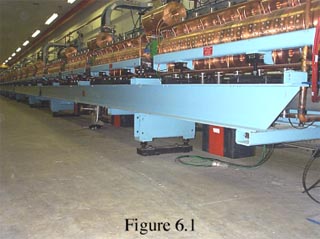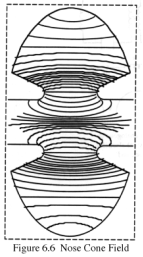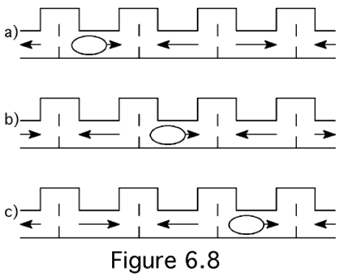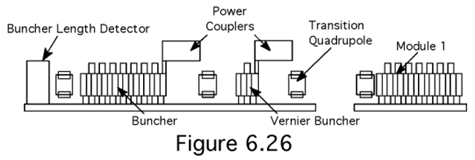|
Fermilab's Linac, LINear ACcelerator, is composed of two different types of accelerating components: drift tubes and side-coupled cavities.
 There are seven side coupled cavities in Linac. The Side-Coupled Linac (SCL) is the second stage. They take the ~116 MeV beam from drift-tube cavities and accelerates the beam to 400 MeV and then sends the beam through the 400 MeV transfer line to the Booster.
There are seven side coupled cavities in Linac. The Side-Coupled Linac (SCL) is the second stage. They take the ~116 MeV beam from drift-tube cavities and accelerates the beam to 400 MeV and then sends the beam through the 400 MeV transfer line to the Booster.
Side Coupled Cavities
The figure to the right shows several side-coupled cavity modules. Each side-coupled cavity module consists of 4 sections with each section containing 16 accelerating cells and 15 coupling cells. The 4 sections are joined together on the module girder by 3 bridge couplers. An 804.96 MHz signal, amplified by a 12 MW Klystron, drives the module. The accelerating gradient for each side-couple cavity module is about 7.5 MV/m, which is three times that of the Drift-Tube Linac (DTL).
Accelerating Side-Coupled Cells
 With side-coupled cavities, each individual cell is a separate accelerating cavity coupled to other cells in the module. The module is not one cavity with drift-tubes, but rather several separate cavities powered by the same RF source by coupling.
With side-coupled cavities, each individual cell is a separate accelerating cavity coupled to other cells in the module. The module is not one cavity with drift-tubes, but rather several separate cavities powered by the same RF source by coupling.
The shape of the nose-cone plays an important part of the accelerating cell. The nose-cone concentrates the field toward the center of the accelerating gap, which creates a stronger field and better acceleration.
This concentrated field accelerates the beam more efficiently than a uniform field across the whole gap. The nose-cone works somewhat like a drift-tube by shielding the beam from electric fields until they're in the direction of maximum acceleration, except that the drift-tubes shield the beam from decelerating fields. The fields in the side-coupled cavities are optimized in the center of the cavity due to the nose-cones.
Coupling
A coupled accelerator is one that has independent resonant cavities that couples the energy between each cavity.

Look at this spring model diagram to see how coupling works. If you start the first mass (m) on the left bouncing, the coupling through the spring (k) would force similar movement on the second mass. The oscillation on the second mass will build until it has reached the same level as the first. While mass one's oscillations are being coupled to mass two, mass two's oscillations are also being coupled to the third mass. Each coupling cavity carries the RF through the entire module to each accelerating cavity.
Cavity Fields
Both the SCL and the DTL operate with a specific phase shift.
 The phase shift describes the phase difference from one cell to a nearby cell. When beam enters the first cell, the field is in the accelerating direction. As beam goes through the nose cone, the fields shift in the other direction. When beam enters the second cell, the field is now in the accelerating direction while the field in the first cell is in the decelerating direction. Since there's no beam in the first cell to see the field, nothing is decelerated. The beam continues to go through the cavities with accelerating fields. The beam pulses travel 8 cells apart in the SCL. There can be up to two pulses in a section and eight pulses in one module.
The phase shift describes the phase difference from one cell to a nearby cell. When beam enters the first cell, the field is in the accelerating direction. As beam goes through the nose cone, the fields shift in the other direction. When beam enters the second cell, the field is now in the accelerating direction while the field in the first cell is in the decelerating direction. Since there's no beam in the first cell to see the field, nothing is decelerated. The beam continues to go through the cavities with accelerating fields. The beam pulses travel 8 cells apart in the SCL. There can be up to two pulses in a section and eight pulses in one module.
SCL Bridge Coupling
The bridge coupler acts as a coupling cell to stabilize the RF before the RF goes to an accelerating cell where it interacts with beam. The bridge coupler is located in the middle of the module to equalize the RF power droop at both ends.
The other two bridge couplers are halfway between the middle bridge coupler and the ends of the module in order to accommodate the quadrupole magnets. Conserving space is important and that's what the bridge couplers do. Besides making room for the quads, the bridge couplers also provide room for trim magnets and diagnostics like BPMs and toroids. Another benefit is that all the quads and diagnostics are easily accessible.

SCL Transition and Buncher
The SCL has two Bunchers that work similarly to the DTL by introducing RF to the beam to begin an energy modulation but no acceleration. The SCL operates with a stronger longitudinal focusing and weaker transverse focusing than the DTL. The transition section changes the shape of the DTL bunches to match the 805 MHz bunch structure of the SCL. The SCL Buncher runs at 2MV/m. Since the 805 MHz bunch structure is focused stronger longitudinally, the Buncher RF speeds up slow particles and slows down fast particles. Both Bunchers have power couplers attached to them to let the RF in. The appearance and function of the power couplers is similar to the bridge couplers.

The figure to the right shows the transition section; it consists of four quads, a Buncher, a Vernier Buncher (simply a second Buncher that improves efficiency), a bunch length detector, and several other diagnostics.
Vacuum Systems
Maintaining vacuum in the Linac transport lines, drift tube and side-coupled cavities allows the beam to travel through the machine without interference from gas molecules. Vacuum also acts as an electrical insulator, allowing high potentials between objects without arcing.
Water Systems
Conventional high-power electrical devices produce a good deal of waste heat. To keep components at operating temperatures many devices use cooling water that has been treated to reduce the number of free ions, which lowers the conductivity. The LCW (Low Conductivity Water) systems are treated, temperature-regulated, and pressurized at the Central Utility Building (CUB). The side-coupled cavities get their cooling from the chilled water system.
Accelerator Update Archive
|  There are seven side coupled cavities in Linac. The Side-Coupled Linac (SCL) is the second stage. They take the ~116
There are seven side coupled cavities in Linac. The Side-Coupled Linac (SCL) is the second stage. They take the ~116  With side-coupled cavities, each individual cell is a separate accelerating cavity coupled to other cells in the module. The module is not one cavity with drift-tubes, but rather several separate cavities powered by the same RF source by coupling.
With side-coupled cavities, each individual cell is a separate accelerating cavity coupled to other cells in the module. The module is not one cavity with drift-tubes, but rather several separate cavities powered by the same RF source by coupling.
 The phase shift describes the phase difference from one cell to a nearby cell. When beam enters the first cell, the field is in the accelerating direction. As beam goes through the nose cone, the fields shift in the other direction. When beam enters the second cell, the field is now in the accelerating direction while the field in the first cell is in the decelerating direction. Since there's no beam in the first cell to see the field, nothing is decelerated. The beam continues to go through the cavities with accelerating fields. The beam pulses travel 8 cells apart in the SCL. There can be up to two pulses in a section and eight pulses in one module.
The phase shift describes the phase difference from one cell to a nearby cell. When beam enters the first cell, the field is in the accelerating direction. As beam goes through the nose cone, the fields shift in the other direction. When beam enters the second cell, the field is now in the accelerating direction while the field in the first cell is in the decelerating direction. Since there's no beam in the first cell to see the field, nothing is decelerated. The beam continues to go through the cavities with accelerating fields. The beam pulses travel 8 cells apart in the SCL. There can be up to two pulses in a section and eight pulses in one module.

